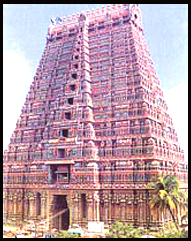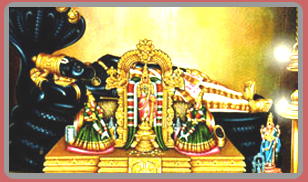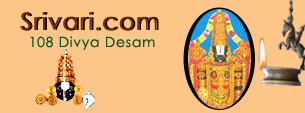|
|
Thiruvarangam - Sri Rangam
|
 |
| History - Thiruvarangam
- Sri Rangam |
 Srirangam
is the foremost of the eight self-manifested shrines (Swayam Vyakta
Kshetras) of Lord Vishnu . It is also considered the first, foremost
and the most important of the 108 main Vishnu temples (Divyadesams).
This temple is also known as Thiruvaranga Tirupati, Periyakoil,
Bhoologa Vaikundam, Bhogamandabam. In the Vaishnava parlance the
term "KOIL" signifies this temple only. The temple is
enormous in size. The temple complex is 156 acres in extent. It
has seven prakaras or enclosures. These enclosures are formed
by thick and huge rampart walls which run round the sanctum. There
are 21 magnificent towers in all prakaras providing a unique sight
to any visitor. this temple lies on an islet formed by the twin
rivers Cauvery and Coleroon. Srirangam
is the foremost of the eight self-manifested shrines (Swayam Vyakta
Kshetras) of Lord Vishnu . It is also considered the first, foremost
and the most important of the 108 main Vishnu temples (Divyadesams).
This temple is also known as Thiruvaranga Tirupati, Periyakoil,
Bhoologa Vaikundam, Bhogamandabam. In the Vaishnava parlance the
term "KOIL" signifies this temple only. The temple is
enormous in size. The temple complex is 156 acres in extent. It
has seven prakaras or enclosures. These enclosures are formed
by thick and huge rampart walls which run round the sanctum. There
are 21 magnificent towers in all prakaras providing a unique sight
to any visitor. this temple lies on an islet formed by the twin
rivers Cauvery and Coleroon.
The temple of Sri Ranganathaswami at Srirangam boasts an historic
past of great kingdom and a civilization thousands of years old.
The reign of the Pallavas was marked by the creation of a solid
religious foundation, for example the encouragement given by the
dynasty appears to have contributed to the growth of Aryan institutions
in Southern India more particularly in the Carnatic. Cholas reigned
for about three hundred years over the Coromandel Coast and the
greater part of Eastern Deccan, where they helped an advanced
Hindu Culture to flourish.
The cholas were defeated in the thirteen century by the Pandyas
of Madurai and Hoysalas of Mysore. Hoysalas had taken particular
interest in the building of the Temple of Srirangam, leaving behind
both the inscriptions and buildings. The Hoysalas were then driven
away by the Pandyas in the early part of fourteenth Century. Later,
the Mohammedans began frequently raiding the Deccan facing strong
resistance from the Hindu Kingdom, which was established in Vijayanagar
in 1336. The Kingdom maintained its independence until 1565.
During this time, the Europeans had appeared in the south of India.
In the sixteenth century a number of foreign travelers and traders
passed through but taking least interest in the hinterland except
for the routes it provided for their trade with the Kingdom of
Vijayanagar. In 1600, the English East India Company was formed,
and 1664 the French company.
In 1680, the last Great Moghul, Aurangazeb (1658-1707), launched
a campaign in western Deccan. After long sieges and a great loss
of life, the fortress cities of Bijapur and Golconda fell to him,
and the campaign lasted until his death.
In Europe, however, the war of Austrian succession set the English
and the French at each other’s throats. Duplex captured
Madras (1746), which was given back to the English two years later.
The French were forced to surrender in 1752 and Duplex was disavowed
and recalled in 1754.
In 1760, a further French attempt, led by Lally-Tollendal, was
unsuccessful and the French trading post was dismantled in 1763.
From then on, the English Company gradually annexed the whole
of the territory of India. Though the French came near to victory,
later on they were defeated in 1798 by the English led by Wellessley
and who invaded Mysore and in 1799 captured the fortress of Srirangapatnam.
There after all of the Southern India came under the supremacy
of England. The Carnatic was included in the direct administration
of the Madras Presidency where it remained.
|
| Architecture |
This temple is the foremost temple in the 108
divya desam of Lord Vishnu. It is considered as the Temple of all
the Vaishnavite temples as it also called as Adhi Rangam. As far
of Vaishnavites are concerned this temple is big in all aspects.
(a) Temple Name : Periya arangam (b) Mulavar Name : Periya Perumal
(c) Thayar Name : Periya Piraati (d) Only temple having Seven inner
Circles. (e) The South Tower towering 236 feet is supposed to be
the highest tower in South-East Asia. (f) The Garudalwar in this
temple is the biggest Garudar in Vaishnavite temples. There are
Seven inner circles in this temple. They are (a) Boologam (Circle
surrounded by Maadangal) (b) Buvarlogam (Circle in memory of Thiru
Vikrama Cholan) (c) Suvarlogam (Circle in memory of Killi Cholan)
(d) Maharlogam (Circle in memory of King Thiru Mangai) (e) Janoologam
(Circle in memory of King Kulasekaran) (f) Thaboologam (Circle in
memory of King Rajemahendra Cholan) (g) Sathyalogam (Circle in memory
of King Dharmavarma Cholan). |
| Mangalasasanam: |
Perialwar - 183, 189,
212, 245, 402-432
Aandaal - 607-616
Kulasekaralwar - 647-676, 728
Thirumazhisaialwar - 772, 800-806, 844, 870, 2384, 2411, 2417, 2441
Thondaradipodialwar - 872-926
Thirupaanalwar - 927-936
Thirumangaialwar - 1019, 1213, 1378-1427, 1506, 1571, 1664, 1829,
1978, 2029, 2038,2043, 2044, 2050, 2062, 2063, 2065, 2069, 2070, 2073-2076,
2673, 2674
Poigaialwar - 2087
Boodathalwar - 2209, 2227, 2251, 2269
Peyalwar - 2342, 2343
Nammalwar - 2505, 3348-3358
Total of 247 Paasurams |
| Special Information |
| Dieties |
Sri Ranganathan, Namperumal, Sriranga Nachiyar |
| Vimanam |
Pranavakaara Vimanam |
| Theerthangal |
River Cauvery, Chandra Pushkarini |
| Mangalasasanam |
Andal, And all Azhwars. |
| Direction and Posture |
Bhujanga Shayanam and South-faced. |
| Features |
- Pattar, Vadakkuth Thiruveethippillai were born here.
- This temple has 7 prakaras. The main sanctum sanctorum alone
spans about half a mile.
|
| Access to the temple |
One can reach Srirangam from Trichi Junction. Trains from main metros
of the country to Trichy are available in plenty. |
| Moolavar |

Sri Ranganathan. Other names of their god is Periya perumal, Nam
Perumal, Azagiya Manavalan. Moolavar in Kidantha Kolam facing south
direction. Prathyaksham for Dharmavarma, Ravindharman, chandiran
and Vibeerhanan. |
| How to Get There. |
Situated in Trichy district near Trichy in
Tamil Nadu. 3/4 kms away from SriRangam railway station which is
in between Vizhupuram - Trichy railway lane. Plenty of buses and
lodging facilities. |
|



